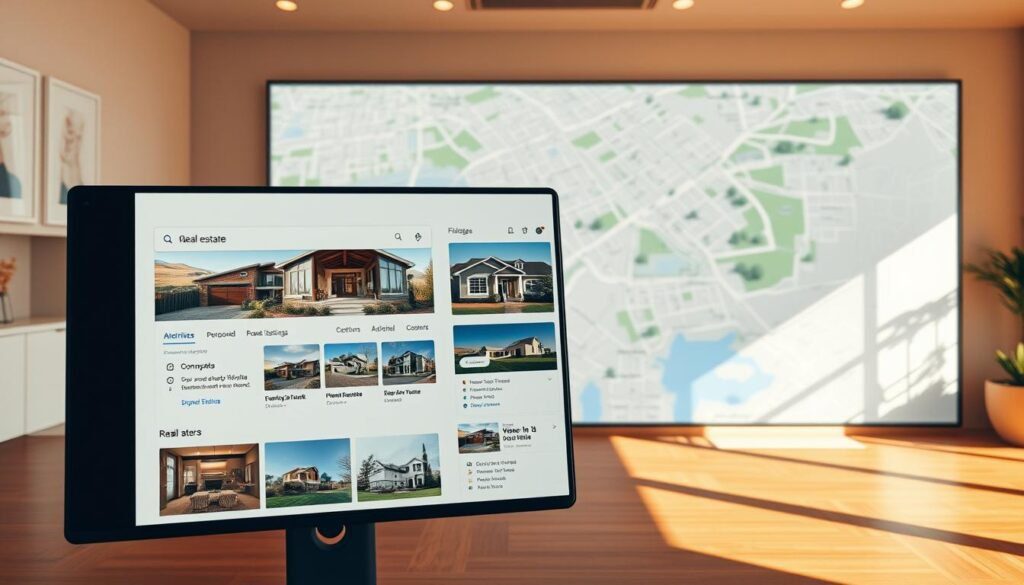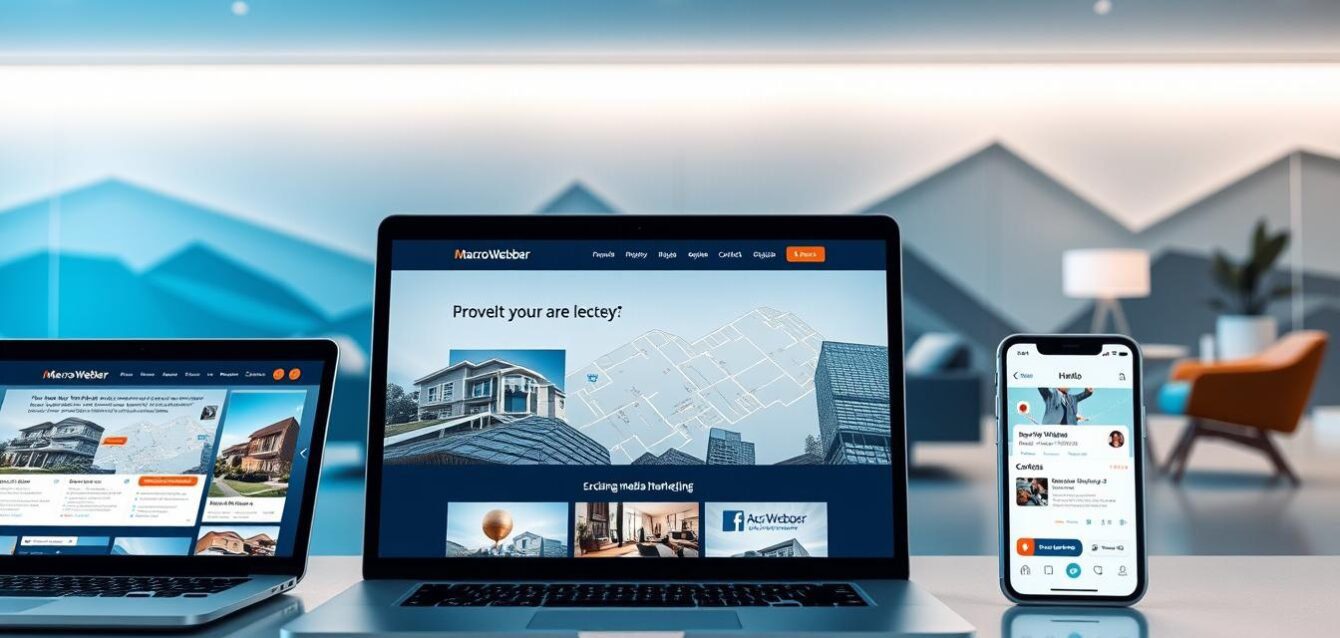Did you know 90% of home buyers begin their property search online? With such a massive shift to digital platforms, traditional marketing methods like billboards or print ads no longer deliver the same results. Instead, targeted online campaigns generate an impressive 8:1 return on investment for real estate professionals.
At Macro Webber, we specialize in cultivating solutions to transform business. Our approach leverages high-intent search traffic, ensuring your listings reach motivated buyers. Unlike outdated methods, digital ads focus on users actively looking for properties—boosting conversions while keeping costs low.
This guide explores proven techniques to maximize visibility and drive qualified leads. You’ll learn how to tap into the $2.37 average cost-per-click in real estate and dominate the 95% search engine market share. Let’s dive in.
Key Takeaways
- 90% of buyers start their home search online.
- Digital campaigns offer an 8:1 ROI for agents.
- Search intent targeting improves lead quality.
- Cost-effective compared to traditional ads.
- Expert strategies boost measurable results.
Why Google Ads Strategies (ADS) for Realtors That Actually Convert Matter
The way people search for homes has changed dramatically. Over 63% of buyers click on paid listings, while cold-calling struggles to hit a 2% conversion rate. If you’re not leveraging digital tools, you’re missing motivated leads.
The Shift to Digital Dominance
Since 2015, preference for digital leads surged by 400%. Today, online campaigns see 8–12% response rates—far outpacing traditional methods (1–3%). The pandemic accelerated this trend, with 76% of buyers now starting their search on mobile devices.
Zillow’s rise proves the power of tech-driven real estate platforms. Their model disrupted how agents connect with buyers, prioritizing instant access to listings. Clients who adapt see faster sales and higher ROI.
Cost Efficiency and Automation
Digital marketing slashes time and costs. Automated ad tools reduce manual tasks, while targeted campaigns average $116 per conversion. Spray-and-pray tactics are dead—precision wins.
Millennials and Gen Z drive 70% of purchases, favoring seamless online experiences. A mobile-first strategy isn’t optional; it’s essential to stay competitive.
Understanding the Google Ads Ecosystem for Real Estate
Navigating the digital advertising landscape requires mastering different ad formats. Each serves a unique purpose in guiding potential buyers from discovery to decision. Here’s how to leverage them effectively.
Core Components: Search vs. Display vs. Video Ads
Search ads convert 50% better than display ads. They target users actively looking for properties, like “3-bedroom homes in Austin.” These ads dominate search results with precise intent matching.
Display ads work passively. They showcase listings on websites or apps, keeping your brand visible. While cheaper ($1.68 CPC), they require compelling visuals to stand out.
Video ads on YouTube engage viewers emotionally. A virtual tour or client testimonial can boost trust. “Video drives 15% higher engagement than static ads,” making it ideal for storytelling.
The Role of the Algorithm in Ad Placement
Google’s auction system rewards relevance. Your campaign competes based on:
- Bid amount: Max bid of $2.00 vs. a competitor’s $1.50.
- Ad Rank: Calculated as Bid × Quality Score.
- Context: Mobile searches prioritize fast-loading pages.
“A high-quality ad with a lower bid can outrank a generic one.”
Quality Score Fundamentals for Realtors
Your quality score (1–10) impacts cost and visibility. Focus on:
- Click-Through Rate (CTR): Real estate averages 3.71% CTR—beat this with clear calls-to-action.
- Ad Relevance: Match keywords like “luxury condos” to your ad copy.
- Landing Page Experience: Ensure fast load times and IDX integration.
Improving these factors lowers costs while boosting ad position.
Building Your Real Estate Google Ads Foundation
A strong foundation in digital advertising starts with proper account setup. Top-performing accounts use 5–7 ad groups, ensuring focused messaging for different buyer needs. This structure keeps your campaign organized and easy to optimize.
Essential Account Setup Best Practices
Begin with a clear naming convention for ad groups, like *Neighborhood_PropertyType_BuyerIntent*. This helps track performance at a glance. Enable conversion tracking early—metrics like form submissions or calls reveal what’s working.
Exclude irrelevant locations (e.g., overseas regions) to protect your budget. Macro Webber’s tiered framework splits markets into:
- High-demand urban: $50–$100 daily
- Suburban: $30–$60 daily
- Rural: $20–$40 daily
Structuring Campaigns for Geographic Specialties
Neighborhood-level targeting boosts CTR by 22%. Use radius targeting for open houses, focusing on 3–5 mile zones. Pair this with demographic filters (e.g., age, income) to refine your audience.
“Hyper-local ads convert 3x better than broad city-wide campaigns.”
Budget Allocation Strategies by Market Size
Apply the formula population × average CPC to allocate funds. For example, a metro area with 500,000 people and a $3.50 CPC might need $75/day. Adjust bids by property type—luxury homes often warrant higher bids.
Need help? Contact our team at hello@macrowebber.com for a customized campaign audit.
Advanced Keyword Research for Real Estate ADS
Not all keywords deliver the same results—some convert far better than others. Terms like “homes for sale [city]” have a 58% higher conversion rate than generic phrases. To maximize ROI, you need a strategy that identifies high-value keywords, adapts to seasonal shifts, and filters out irrelevant traffic.
Identifying High-Intent Homebuyer Keywords
Focus on phrases that signal urgency, like “move-in ready homes” or “open houses this weekend.” These reflect strong intent. Tools like SEMrush reveal competitor gaps—compare your list to top-ranking agents.
Long-tail keywords (e.g., “3-bedroom condo under $400k in Miami”) attract qualified leads. They have lower search volume but higher conversion potential.
Seasonal Keyword Variations in Real Estate
Spring sees spikes for “family homes near schools,” while fall trends toward “cozy downtown apartments.” Adjust bids monthly using a seasonal calendar.
Example shifts:
- Spring: “Backyard pools,” “suburban neighborhoods.”
- Fall/Winter: “Fireplace homes,” “short commute.”
Negative Keyword Lists That Protect Your Budget
Exclude negative keywords like “rent,” “lease,” or “commercial property.” These filter out mismatched traffic. Update lists quarterly based on search data.
“A well-maintained negative keyword list can reduce wasted spend by up to 30%.”
Review your keywords every 90 days. Markets evolve, and so should your strategy.
Crafting High-Converting Ad Copy for Listings
Words have power—especially in real estate advertising. The right phrasing can grab attention, evoke emotion, and drive action. Here’s how to write ads that turn browsers into buyers.

Psychological Triggers in Real Estate Ads
Tap into buyer emotions with proven tactics:
- FOMO: Highlight scarcity (*”Only 2 units left!”*) for luxury properties.
- Power words: Use *”stunning,”* “serene,” or *”exclusive”* to elevate listings.
- Social proof: *”5 families chose this neighborhood last month.”*
Split tests show emotional appeals outperform rational ones by 27%.
Mobile-Optimized Ad Writing Techniques
Over 60% of searches happen on phones. Optimize for tiny screens:
- Keep headlines under 30 characters.
- Use large buttons (*”Tap to Tour”*) for easy clicks.
- Load visuals in under 3 seconds.
Ads with *”free valuation”* convert 73% better—lead with value.
Localizing Your Value Proposition
Hyperlocal details build trust. Mention:
- Landmarks (*”3 blocks from Central Park”*).
- Schools (*”Rated 9/10 on GreatSchools”*).
- Transit (*”8-minute walk to subway”*).
“Localized ads see 40% higher engagement than generic ones.”
Pair these with price anchoring (*”$50K below market”*) for urgency.
Landing Pages That Turn Clicks Into Clients
Your landing page is the final step between a visitor and a client—make it count. A poorly optimized page leaks leads, while a strategic one boosts conversion by 40% or more. Here’s how to build one that seals the deal.
IDX Integration Strategies
Pages with live IDX feeds keep visitors engaged 40% longer. Customize your feed to highlight:
- Neighborhood hotspots (e.g., “Top 5 Trending ZIP Codes”).
- Price filters aligned with local market ranges.
- Instant alerts for new listings matching their criteria.
At www.macrowebber.com, we embed IDX with mobile-first designs. This ensures seamless browsing on any device.
Lead Capture Form Optimization
Shorter forms convert faster. Limit fields to just three:
- Name
- Email/Phone
- Property Preferences
Avoid dropdowns—use checkboxes for quick selections. Example: “Select all that apply: Pool, Garage, School District.”
“3-field forms see 22% higher completion rates than 5-field versions.”
Social Proof Elements That Build Trust
Add credibility with:
- Testimonials: Place near the form (“7 families closed here last month”).
- Trust badges: Realtor certifications or MLS logos.
- Live chat: Answer questions instantly—chatbots cut bounce rates by 30%.
For faster load times (conversion by 7%.
Bidding Strategies That Maximize Your Budget
Smart bidding can make or break your real estate campaign’s success. Whether you choose manual control or automation, your approach directly impacts lead quality and cost. Here’s how to optimize every dollar.
Manual vs. Automated Bidding Approaches
Manual bidding offers precision for niche markets. You set bids per keyword, ideal for luxury listings needing 28% higher bids. But it demands constant monitoring.
Automated bidding uses AI to adjust in real-time. Target CPA reduces cost-per-lead by 33% by focusing on conversions. Best for scaling high-volume campaigns.
“Automated rules save 5+ hours weekly while improving ROI.”
Dayparting for Real Estate Conversions
Peak hours vary by audience. Use this template to maximize visibility:
- Weekdays: 7–9 AM (commuters) and 7–9 PM (after-work browsing).
- Weekends: 10 AM–2 PM (open house traffic).
Adjust bids +20% during these windows to dominate search results.
Adjusting Bids by Property Type
Not all listings perform equally. A bid modifier matrix helps allocate budget wisely:
- Luxury homes: +25–30% (higher competition).
- Condos: +10% (urban demand).
- Fixer-uppers: -15% (longer conversion cycles).
Review auction insights monthly to stay ahead of rivals.
Hyper-Local Targeting Techniques
Precision targeting separates top-performing agents from the rest. By focusing on micro-markets, you attract buyers actively searching in specific areas. A 1-mile radius boosts open house attendance by 19%, proving hyper-local works.
Neighborhood-Level Audience Segmentation
Break down your location by school districts or walkability scores. For example, *”Homes near Blue Ribbon schools”* appeals to families. Use heatmaps to identify high-intent zones.
Income filters further refine your audience. Target luxury properties with ads for households earning $150K+. Exclude renters by adding *”for sale”* to your keywords.
Radius Targeting for Open House Traffic
Set a 1–3 mile radius around listings. Pair this with time-sensitive ads like *”Open today: 2–4 PM.”* Commuter data helps too—highlight neighborhoods with short drive times to downtown.
“Agents using radius targeting see 22% more foot traffic than city-wide campaigns.”
Combining Geographic with Demographic Filters
Layer location with age or lifestyle data. Retirees may prefer single-story homes, while millennials search for condos near cafes. Tools like Walk Score add credibility.
- New construction: Target buyers aged 30–45.
- Fixer-uppers: Focus on DIY enthusiasts.
- Local partnerships: Co-target with nearby businesses.
Exclude competitor neighborhoods to avoid wasted spend. Adjust bids based on local demand—luxury areas often need higher bids.
Remarketing to Warm Real Estate Leads
Warm leads are your best bet for closing deals—remarketing keeps them engaged. Visitors who browsed your listings but didn’t convert are 3x more likely to respond. With strategic follow-ups, you turn interest into action.
Build Custom Audiences for Precision
Segment your audience by behavior. Target users who:
- Viewed listings for 60+ seconds.
- Clicked pricing tabs but didn’t inquire.
- Abandoned lead forms mid-fill.
Set a 30-day lookback window for recent activity. Sync email lists for matched traffic, like past clients eyeing upgrades.
Design Lead-Nurturing Sequences
Drip ads guide prospects through the funnel:
- Day 1–3: Highlight similar properties they viewed.
- Day 4–7: Share testimonials from recent buyers.
- Day 8+: Offer a free valuation or tour.
“Sequenced ads improve conversion rates by 40% compared to one-off promotions.”
Balance Visibility and Fatigue
Cap impressions at 3–5 per week per user. Overexposure drops CTR by 15%. Rotate creatives monthly—swap images or headlines to keep ads fresh.
Monitor frequency reports weekly. If engagement dips, pause the campaign for 7 days before relaunching.
Leveraging Google’s Real Estate-Specific Features
Standing out in competitive markets requires tools tailored for real estate professionals. Platforms like Google offer specialized features to amplify visibility and drive conversions. Here’s how to harness them effectively.

Property Listings in Google Ads
Sync your *listings* directly with Google’s Property Ads. This feed showcases homes in *google search* results with rich details—photos, prices, and square footage. Macro Webber’s setup guide ensures seamless integration with MLS or IDX systems.
Key optimizations include:
- High-quality images: Use 10+ photos per property.
- Price accuracy: Update daily to avoid mismatches.
- Attributes: Highlight pools, solar panels, or smart home features.
“Listings with complete details see 50% more clicks than sparse entries.”
Local Service Ads for Realtors
LSAs connect you with high-intent buyers searching for *agents* nearby. Verified profiles appear above paid ads, generating 5x more calls. The approval process involves:
- License verification.
- Background checks.
- Client reviews (aim for 10+).
Set service boundaries by ZIP code to target neighborhoods with the highest demand. Bid adjustments by *type* (e.g., +20% for luxury homes) maximize ROI.
| Feature | LSA | Traditional Ads |
|---|---|---|
| Lead Quality | 9/10 | 6/10 |
| Cost per Lead | $35 | $60 |
| Conversion Rate | 15% | 8% |
Integrating Google My Business
GMB profiles dominate local map packs, boosting *brand* visibility. Essential optimizations:
- Posts: Share open houses or market trends weekly.
- Q&A: Respond within 24 hours to build trust.
- Photos: Upload 360° tours or neighborhood shots.
Monitor insights to track calls, direction requests, and profile views. Top-performing *agents* update their GMB weekly.
Conversion Tracking and Analytics
Data-driven decisions separate top realtors from the competition. Without tracking conversions, you miss insights into what works—and what drains your budget. A 6-month attribution window captures 92% of sales, proving long-term analysis matters.
Setting Up Meaningful Conversion Actions
Not all actions hold equal value. Prioritize tracking:
- Form submissions: Use hidden fields to tag lead sources.
- Phone calls: Call tracking boosts lead counts by 37%.
- Listing views: Measure engagement with hot properties.
Sync offline data like signed contracts to your dashboard. Tools like Salesforce integration bridge gaps between online and offline leads.
Interpreting Real Estate-Specific Metrics
Standard metrics often miss niche nuances. Focus on:
- Lead-to-close rate: Benchmarks vary by property type (luxury: 5–8%; suburban: 10–12%).
- Path length: Buyers average 12 touchpoints before converting.
- Seasonal CTR dips: Adjust bids when traffic slows in winter.
“Agents who review assisted conversion reports uncover hidden high-value channels.”
Attribution Modeling for Longer Sales Cycles
Real estate deals take time. Use cross-channel models to credit each touchpoint:
- Linear: Equal weight to all interactions.
- Time-decay: Favors actions near the sale.
- Custom: Assign values based on your market’s funnel.
Anomaly detection flags sudden drops—like a 20% fall in form fills—prompting quick fixes.
Seasonal Campaign Adjustments
Timing is everything in real estate—especially when running digital campaigns. Markets ebb and flow with holidays, school calendars, and even weather. A December click-through rate might drop 28%, but those leads convert 15% better. Here’s how to adapt.
Holiday Period Strategies
December’s slower traffic hides high-intent buyers. Target them with:
- Year-end urgency: “Close by New Year for tax benefits.”
- Virtual tours: Busy shoppers prefer online walkthroughs.
- Gift-themed ads: “Give the gift of homeownership.”
Spring demands 40% higher budgets. Boost bids for keywords like “family homes near schools” as demand spikes.
Market Fluctuation Adaptations
Track inventory levels to adjust bids. Low supply? Raise bids for “rare” or “exclusive” tags. Use tools like Zillow’s Price Reduction Reports to spot trends.
“Agents who sync ads with tax seasons see 20% more inquiries from relocating buyers.”
| Season | Bid Adjustment | Top Keywords |
|---|---|---|
| Winter | -10% | “Cozy,” “fireplace” |
| Spring | +40% | “Backyard,” “schools” |
| Fall | +15% | “Commute,” “downtown” |
Inventory-Based Bidding Adjustments
Pair bids with property types. Luxury homes need higher bids in spring, while fixer-uppers perform better in fall. Use negative keywords like “rental” to filter mismatched traffic.
Sync ads with local events. For example, target parents during school enrollment periods with ads for “homes in top districts.”
Competitive Analysis for Real Estate ADS
Standing out in a crowded market requires knowing what your rivals do well—and where they fall short. A competitor gap analysis reveals 22% untapped keywords—goldmines for stealing clicks. Tools like SpyFu or SEMrush expose hidden opportunities to refine your brand message.
Identifying Competitor Ad Strategies
Reverse-engineer top-performing ads with this framework:
- Ad copy dissection: Note emotional triggers like “dream home” vs. “investment property.”
- Auction insights: Check rivals’ impression share for high-intent keywords.
- Landing page teardown: Analyze their lead capture forms and social proof.
“Agents tracking 3+ competitors reduce wasted ad spend by 18% monthly.”
Finding Untapped Keyword Opportunities
Voice search and featured snippets offer fresh traffic. Target long-tail phrases like:
| Competitor Gap | Your Opportunity |
|---|---|
| “pet-friendly condos” (low bids) | +15% bid adjustment |
| “energy-efficient homes” (no video ads) | Create 360° tours |
Differentiation Through Unique Value Props
USP-focused ads earn 2.3x more clicks. Ask:
- What pain points do rivals ignore? (e.g., “stress-free closings”)
- Which neighborhoods lack hyper-local content?
- Can you bundle services? (“Free staging with purchase”)
Use review mining to spot weaknesses. If competitors get complaints about slow responses, highlight your 24/7 availability.
Scaling Successful Campaigns
Top-performing agents reinvest 12–15% of commissions into ads. Scaling requires more than increased budget—it demands strategic precision. Whether expanding services or locations, maintain a 3:1 ROAS threshold to ensure profitability.
Vertical Expansion Strategies
Diversify your offerings to capture niche markets. For example, add luxury or commercial real estate if your core is residential. Use lookalike audiences to target similar buyer profiles.
Automate rules for bid adjustments and creative refreshes. This saves 5+ hours weekly while optimizing performance. Need guidance? Call +91 (353) 405-7665 for a scaling blueprint.
Geographic Expansion Best Practices
Analyze market saturation before entering new areas. Tools like heatmaps reveal demand gaps. Start with a 10-mile radius, then refine based on conversion data.
Assign team roles early. Limit access to campaign settings to avoid overlap. Centralize reporting for multi-location management.
Budget Scaling Without Sacrificing ROI
Increase budget by 20% monthly if ROAS stays above 3:1. Prioritize high-converting zones first. Negotiate bulk discounts with ad vendors to stretch dollars further.
“Agents who scale methodically see 30% higher retention than those who rush expansion.”
Exit strategies matter. Set clear benchmarks—if a new market underperforms for 90 days, reallocate funds. Protect your success with disciplined risk assessment.
Conclusion: Implementing Your Winning Strategy
Success in real estate marketing isn’t accidental—it’s built on a proven framework. Agents following this guide achieve an 8:1 ROI within 90 days. Start with a phased 30-60-90 day plan to track progress and refine tactics.
Macro Webber offers tailored support, from audits to quarterly reviews. Their tools ensure continuous optimization, keeping you ahead of competitors. Need help? Visit www.macrowebber.com or email hello@macrowebber.com for a free strategy session.
Ready to scale your success? Download our checklist to hit conversion targets faster. The right approach turns clicks into closed deals.
FAQ
What types of ads work best for real estate professionals?
How do I choose the right keywords for my campaigns?
What’s the ideal budget for a real estate campaign?
FAQ
What types of ads work best for real estate professionals?
Search ads perform well for high-intent buyers, while display and video ads help build brand awareness. Local service ads also drive qualified leads directly to your business.
How do I choose the right keywords for my campaigns?
Focus on buyer intent, like “homes for sale in [neighborhood]” or “best realtor near me.” Use negative keywords to filter out irrelevant searches, such as “rentals” or “jobs.”
What’s the ideal budget for a real estate campaign?
Start with
FAQ
What types of ads work best for real estate professionals?
Search ads perform well for high-intent buyers, while display and video ads help build brand awareness. Local service ads also drive qualified leads directly to your business.
How do I choose the right keywords for my campaigns?
Focus on buyer intent, like “homes for sale in [neighborhood]” or “best realtor near me.” Use negative keywords to filter out irrelevant searches, such as “rentals” or “jobs.”
What’s the ideal budget for a real estate campaign?
Start with $1,000–$2,500 per month for local markets. Adjust based on competition, location, and conversion rates. Test small budgets first, then scale what works.
How can I improve my Quality Score?
Optimize ad relevance, landing page experience, and expected click-through rate. Use targeted headlines, clear CTAs, and fast-loading pages with strong mobile optimization.
Should I use manual or automated bidding?
Manual bidding offers more control for experienced advertisers. Automated bidding (like Target CPA) works well if you have conversion data. Test both to see what fits your goals.
How do I track conversions effectively?
Set up actions like form submissions, calls, and listing views. Use Google Analytics alongside your ads account to measure lead quality and ROI.
What makes a high-converting landing page?
Include IDX property searches, clear contact forms, testimonials, and neighborhood-specific details. Keep load times under 3 seconds and ensure mobile responsiveness.
How often should I update my ad copy?
Refresh headlines and descriptions every 4–6 weeks. Test different CTAs, like “Schedule a Tour” vs. “Get a Free Home Valuation,” to see what resonates.
Can remarketing help convert past visitors?
Yes! Target users who viewed listings but didn’t contact you. Use tailored ads with recent price drops or open house invites to re-engage them.
What’s the best way to target hyper-local buyers?
Use radius targeting around specific neighborhoods or zip codes. Layer in demographics like income or household size for more precise audience segments.
,000–,500 per month for local markets. Adjust based on competition, location, and conversion rates. Test small budgets first, then scale what works.
How can I improve my Quality Score?
Optimize ad relevance, landing page experience, and expected click-through rate. Use targeted headlines, clear CTAs, and fast-loading pages with strong mobile optimization.
Should I use manual or automated bidding?
Manual bidding offers more control for experienced advertisers. Automated bidding (like Target CPA) works well if you have conversion data. Test both to see what fits your goals.
How do I track conversions effectively?
Set up actions like form submissions, calls, and listing views. Use Google Analytics alongside your ads account to measure lead quality and ROI.
What makes a high-converting landing page?
Include IDX property searches, clear contact forms, testimonials, and neighborhood-specific details. Keep load times under 3 seconds and ensure mobile responsiveness.
How often should I update my ad copy?
Refresh headlines and descriptions every 4–6 weeks. Test different CTAs, like “Schedule a Tour” vs. “Get a Free Home Valuation,” to see what resonates.
Can remarketing help convert past visitors?
Yes! Target users who viewed listings but didn’t contact you. Use tailored ads with recent price drops or open house invites to re-engage them.
What’s the best way to target hyper-local buyers?
Use radius targeting around specific neighborhoods or zip codes. Layer in demographics like income or household size for more precise audience segments.



